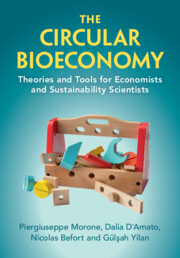Book contents
- The Circular Bioeconomy
- The Circular Bioeconomy
- Copyright page
- Contents
- Figures
- Tables
- Preface
- Acknowledgements
- Note on the Text
- Abbreviations and Notations
- Part I
- 1 The Historical Origins of the Bioeconomy
- 2 Emerging Bioeconomy Narratives
- 3 The Bioeconomy, the Green Economy, and the Circular Economy
- Part II
- Part III
- Index
- References
1 - The Historical Origins of the Bioeconomy
from Part I
Published online by Cambridge University Press: 26 October 2023
- The Circular Bioeconomy
- The Circular Bioeconomy
- Copyright page
- Contents
- Figures
- Tables
- Preface
- Acknowledgements
- Note on the Text
- Abbreviations and Notations
- Part I
- 1 The Historical Origins of the Bioeconomy
- 2 Emerging Bioeconomy Narratives
- 3 The Bioeconomy, the Green Economy, and the Circular Economy
- Part II
- Part III
- Index
- References
Summary
To understand the roots of the bioeconomy, it is necessary to look back at two historical episodes with similar characteristics. On the one hand, during the 1920s and 1930s in the United States, some actors joined forces to develop a chemurgy aimed at creating industrial products on the basis of agricultural substrates. On the other hand, during the years 1976 to 1980, the crisis in petroleum-based chemistry led to the idea of a revival based on the chemistry of sugars. In this chapter, we will do so by analysing the way actors have defined how the use of renewable resources in substitution of oil should be organised.
- Type
- Chapter
- Information
- The Circular BioeconomyTheories and Tools for Economists and Sustainability Scientists, pp. 3 - 14Publisher: Cambridge University PressPrint publication year: 2023



